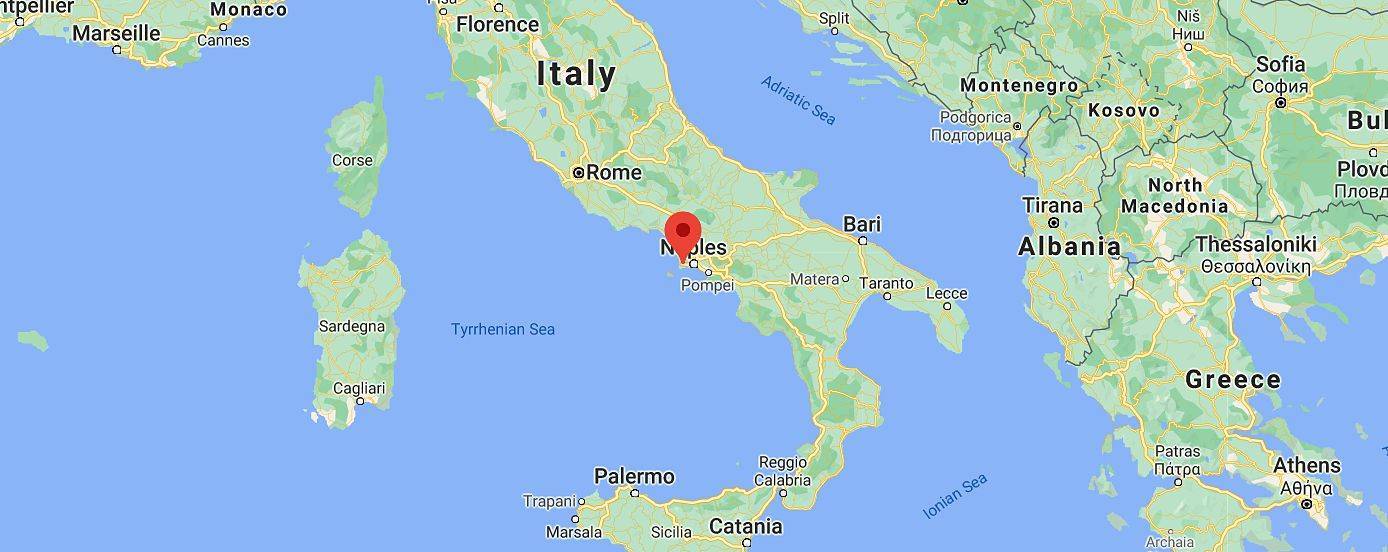What Are Pozzolans?
Pozzolans (or in Italian: pozzolana) are various glassy materials (e.g. specific natural sands, ashes or powders) mixed into lime that can make lime plasters hydraulic, which is water resistant or even completely waterproof. The name originates from the town Pozzuoli, located in the Bay of Naples surrounding the Vesuvius volcano.

Puozzoli, Italy - where natural pozzolans originate from
Natural Pozzolans
Around 500 B.C. the ancient Greeks, then later the Romans have discovered that by mixing lime putty with natural volcanic ashes and sands rich in silica (SiO2) and alumina (Al2O3), in the presence of water certain chemical reactions (pozzolanic reactions) took place, resulting in water-resistant or completely waterproof lime mixes that can even harden underwater.
This has been highlighted 2,000 years ago by the famous Roman architect and engineer Vitruvius, author of the 10-volume architectural handbook On Architecture, where he wrote: “There is a kind of dust called "pozzolana" (named from Pozzuoli) which by nature possesses extraordinary qualities. It is located in the Bay of Naples and in the lands surrounding Vesuvius. This powder, mixed with lime and sand, makes the masonry so stable that it hardens not only in normal buildings, but also under water.”
These volcanic ashes and sands - the pozzolans - are formed during explosive volcanic eruptions. Molten magma is projected into the air, then the sudden pressure decrease following that releases gases from the molten magma, resulting in the formation of a highly porous, breathable microstructure. Moreover, the rapid cooling of the magma (either in air or water) is responsible for its glassy state, capable of reacting with lime.
These pozzolans, being essentially microporous sands, result in lime mortars which are not only waterproof but retain the breathability of traditional lime putty mortars.

The highly porous structure of a natural volcanic pozzolan
Over time natural physical and chemical processes (temperature, pressure, weathering etc.) have compacted many deposits of volcanic ashes into tuff - another pozzolanic material. Tuff is a relatively soft rock containing more than 75% volcanic ash, which has been used by the Romans for the construction of walls since ancient times.

Tuff - a soft volcanic stone with pozzolanic properties
The discovery and use of natural pozzolans and pozzolanic lime mortars have revolutionized construction during the antiquity, contributing to the evolution of a new Roman architecture resulting in monumental constructions such as the Pantheon or the Baths of Caracalla - which lasted 2,000 years.
Other types of natural pozzolans also exist in other countries in smaller quantities.
Artificial Pozzolans
The term "pozzolans" today are primarily known from cement manufacturing, where artificial pozzolans - waste materials or byproducts with pozzolanic (waterproofing) properties - are used into modern concrete to improve its properties.
Although these artificial pozzolans perform a somewhat similar function to natural pozzolans, their structure is very different and their use is practically limited to cement manufacturing, with very limited use in lime.
Here are the most common artificial pozzolans:
Blast Furnace Slag

Blast furnace slags are glass-like by-products of the iron manufacturing industry after the metal has separated from the raw ore. They are high in SiO2 (silica) and often in Al2O3 (alumina). They are mixed into concrete in variable percentages (typically between 45% to 80%) to replace Portland cement.
- Advantages: less costly than Portland cement, good salt resistance, good long-term mechanical strength.
- Disadvantages: longer setting times (slower drying), lower short-term mechanical strength.
Fly Ash

Fly ash (also known as flue ash or coal ash) is a fine gray dust - consisting mostly of small (5-90 µm) glassy micro-spheres - left over after burning coal in coal-fired power plants. In the past fly ash was generally released into the atmosphere, but today, to minimize pollution, it is captured and some of it is recycled during concrete production.
Because fly ash contains high amounts of SiO2 (about 50%), Al2O3 (about 30%), they are mixed to concrete (in a proportion of 35% to 45%) replacing Portland cement.
- Advantages: better workability of concrete thanks to its micro-sphere structure; better salt resistance (resistance to chemical attacks).
- Disadvantages: the presence of unburnt carbon often interferes with other additives; longer setting times (slower drying), lower short-term mechanical strength.
Silica Fumes

Silica fumes (also known as microsilica) are a by-product of alloy-production (e.g. aluminum and steel production). They are composed almost exclusively of tiny (0.1 µm) SiO2 glassy micro-spheres, These being 100 - 150 times smaller than a grain of cement, when mixed in concrete by filling the small voids, results in a very durable, high strength concrete.
- Advantages: low permeability concrete with high mechanical resistance.
- Disadvantages: greater demand for water; lower workability if used in higher percentages than 10-15%.







